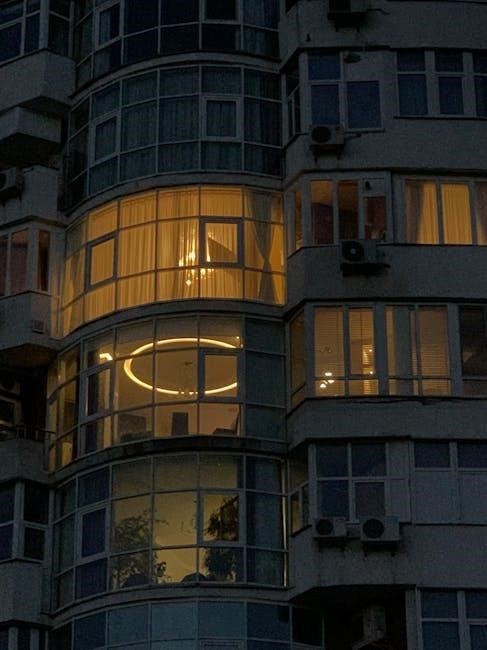Discover the ultimate resource for understanding windows, from types and materials to energy efficiency and installation. This guide helps homeowners make informed decisions for their homes.
Explore various window styles, glass options, and maintenance tips to enhance your home’s functionality and aesthetics. Whether replacing or installing, this guide covers everything you need to know.
Overview of Window Types and Styles
Windows come in a wide variety of types and styles, each offering unique benefits for different home designs and climates. Popular options include single-hung, double-hung, casement, awning, sliding, bay, bow, and picture windows. Storm windows provide additional protection, while hopper windows are ideal for basements. Fixed windows are great for views but don’t open, whereas sliding windows save space. The choice depends on factors like ventilation needs, energy efficiency, and aesthetic preferences. Understanding these options helps homeowners select the perfect fit for their lifestyle and architectural style, ensuring functionality and beauty.
Importance of Windows in Home Design
Windows play a crucial role in home design, impacting both functionality and aesthetics. They provide natural light, ventilation, and stunning views, enhancing indoor comfort and ambiance. Energy-efficient windows can reduce heating and cooling costs, while stylish designs boost curb appeal. Their placement and size influence a room’s atmosphere, making spaces feel larger or cozier. Windows also serve as a design element, reflecting architectural styles and personal taste. Investing in quality windows not only improves livability but also increases a home’s value, making them a vital component of any dwelling.
Basic Components of a Window
A window consists of several key components that ensure its functionality and durability. The frame provides structural support, while the sash holds the glass panes in place. The panes themselves can be single, double, or triple-glazed for energy efficiency. Mullions separate multiple panes, adding a decorative touch. Hardware, such as hinges and handles, allows for smooth operation. The sill is the bottom part of the frame, and the head is the top. These elements work together to create a functional and aesthetically pleasing window system for homes.

Types of Windows
Windows come in various styles and materials, offering functionality and aesthetics for different homes and climates. From traditional to modern designs, each type enhances your space uniquely.
Single-Hung Windows
Single-hung windows feature a classic design with one movable sash, typically the bottom one, while the top sash remains fixed. This style is known for its simplicity and affordability, offering easy maintenance and operation. The single-hung design provides excellent sealing, reducing air leakage and improving energy efficiency. They are ideal for traditional home designs and are available in various materials, including vinyl, wood, and aluminum. These windows are a cost-effective solution for homeowners seeking functionality without compromising on style or performance.
Double-Hung Windows
Double-hung windows offer versatility with two movable sashes, allowing both the top and bottom panels to slide open. This feature enhances ventilation and ease of cleaning, as both sashes can be tilted inward. They are suitable for various architectural styles and provide excellent airflow control. Double-hung windows are energy-efficient and customizable in materials like wood, vinyl, or aluminum. Their classic design blends seamlessly with traditional and modern homes, making them a popular choice for homeowners seeking functionality, durability, and aesthetic appeal.
Casement Windows
Casement windows are hinged on one side and swing outward like a door, offering excellent ventilation and energy efficiency. Operated by a crank handle, they provide easy access and a tight seal when closed. Their design allows for unobstructed views and is ideal for modern and contemporary homes. Casement windows are customizable in materials like wood, vinyl, and fiberglass, ensuring durability and aesthetic appeal. They are also known for their security features and low maintenance, making them a popular choice for homeowners seeking both functionality and style.
Awning Windows
Awning windows are hinged at the top and open outward, offering excellent ventilation and views. Their unique design allows for partial opening, making them ideal for rainy days. Typically operated by a crank or motor, they are energy-efficient and provide a tight seal when closed. Awning windows are versatile, suitable for both modern and traditional homes, and can be paired with other window styles. They are durable, low maintenance, and available in various materials like wood, vinyl, and fiberglass, ensuring a perfect fit for any home design while enhancing functionality and aesthetic appeal.
Sliding Windows
Sliding windows glide horizontally along a track, offering a sleek, modern look. They are easy to operate and provide wide openings for ventilation and views. Durable and low maintenance, they are ideal for contemporary homes. Available in various materials, sliding windows are energy-efficient and cost-effective. Their design complements both traditional and modern architectures, making them a versatile choice for homeowners seeking functionality and style. With minimal effort, they enhance indoor-outdoor connections, making them perfect for living rooms or kitchen areas.
Bay Windows
Bay windows are multi-panel windows that project outward from a home’s exterior wall, creating a protruding section. They typically consist of a central fixed window flanked by two operable windows. This design adds architectural interest and increases interior space. Bay windows allow ample natural light and offer expansive views, making them ideal for living rooms, kitchens, or reading nooks. They are available in various styles and materials, such as vinyl or wood, and can be customized to suit different home designs.
Known for their energy efficiency and durability, bay windows enhance both functionality and aesthetics. They are a popular choice for homeowners seeking to add charm and value to their homes.
Bow Windows
Bow windows are curved or angled window units that add a unique, elegant touch to a home’s exterior. They consist of multiple glass panels joined at adjustable angles, creating a gentle arch. This design allows for maximum natural light and offers a wider view of the outdoors. Bow windows are ideal for modern and traditional homes, enhancing both aesthetics and functionality.
Available in various materials like vinyl or wood, bow windows can be customized to match any architectural style. They are energy-efficient and durable, making them a popular choice for homeowners seeking to add charm and sophistication to their living spaces.
Picture Windows
Picture windows are large, fixed glass panels designed to provide unobstructed views of the outdoors. They do not open, making them ideal for capturing scenic vistas while allowing ample natural light to enter the room. Available in various shapes and sizes, picture windows can be customized to fit any home’s architecture. They are energy-efficient and require minimal maintenance, making them a popular choice for homeowners seeking to enhance their interior and exterior spaces with a touch of modern elegance and functionality.
Storm Windows
Storm windows are additional protective panels installed over existing windows to shield homes from severe weather conditions. They are typically mounted on the interior or exterior and are designed to withstand heavy rain, strong winds, and debris. These windows enhance energy efficiency by reducing heat loss and preventing air leaks. They also provide noise reduction and protect the primary windows from damage. Storm windows are a practical solution for homeowners in areas prone to harsh weather, offering durability and low maintenance while preserving the aesthetic appeal of the home.
Hopper Windows
Hopper windows are a unique type of window that opens by tilting inward from the top. They are typically small and circular or oval-shaped, often used in basements, attics, or bathrooms for ventilation. These windows are energy-efficient and provide excellent insulation due to their tight seal when closed. Hopper windows are low-maintenance and easy to clean, making them a practical choice for spaces requiring minimal upkeep. Their compact design allows for installation in tight spaces, enhancing airflow without compromising security or aesthetic appeal. They are ideal for areas needing controlled ventilation and a sleek, modern look.
Window Materials and Construction
Windows are crafted from materials like wood, vinyl, aluminum, and fiberglass, each offering unique benefits. Construction focuses on durability, energy efficiency, and aesthetic appeal to suit various home designs.
Wood Windows
Wood windows are a classic choice, offering timeless beauty and durability. They can be painted or stained to match any home style, providing versatility in design. Known for their natural insulation properties, wood windows help reduce energy costs. However, they require regular maintenance, such as painting, to protect against rot and moisture damage. Despite this, they remain a popular option for their aesthetic appeal and ability to enhance a home’s value. Wood windows also offer a sustainable choice, as they are made from renewable resources, making them an eco-friendly option for homeowners.
Vinyl Windows
Vinyl windows are a popular choice for their durability and low-maintenance requirements. Made from polyvinyl chloride (PVC), they are resistant to rot, rust, and insect damage. Vinyl windows are energy-efficient, often featuring double-pane glass to reduce heat transfer and noise. They come in a variety of styles, including casement, sliding, and double-hung designs. Unlike wood windows, vinyl windows do not require painting and are easy to clean, making them a practical option for homeowners. Their affordability and long lifespan make them a cost-effective choice for both new constructions and window replacement projects.
Aluminum Windows
Aluminum windows are known for their sleek, modern design and durability. They are lightweight yet strong, making them ideal for large window openings. Aluminum frames are corrosion-resistant and require minimal maintenance. They can be painted or finished in various colors to match home aesthetics. These windows are energy-efficient, especially when paired with thermal breaks to reduce heat transfer. Aluminum windows are a great choice for contemporary homes, offering a balance of style, strength, and functionality. Their slim profiles allow for more glass, providing unobstructed views and natural light.
Fiberglass Windows
Fiberglass windows are a durable and low-maintenance option, offering excellent strength and resistance to warping or rotting. Made from glass fibers embedded in a resin, they provide superior insulation and energy efficiency. Their slim profiles mimic traditional wood windows while requiring less upkeep.
Fiberglass windows are also eco-friendly, as they can be made from recycled materials. They come in various styles and finishes, including wood grain textures, making them a versatile choice for modern and traditional homes alike. Their long lifespan and minimal maintenance make them a cost-effective solution for homeowners seeking reliability and style.
Composite Windows
Composite windows combine materials like wood and vinyl for enhanced durability and performance. They offer a blend of traditional aesthetics and modern functionality, making them a popular choice for homeowners. Known for their strength and resistance to rot and insects, composite windows are ideal for various climates.
These windows provide excellent energy efficiency and require minimal maintenance. Their hybrid construction ensures a long lifespan while maintaining a classic appearance. Composite windows are a versatile and practical option for those seeking a balance between style, durability, and cost-effectiveness.

Window Glass Options
Explore various glass options for your windows, including single-pane, double-pane, and triple-pane designs. Low-E, tinted, and impact-resistant glass offer enhanced energy efficiency, privacy, and durability.
Single-Pane Glass
Single-pane glass is a cost-effective option offering simplicity and ease of use. Ideal for mild climates, it provides natural light and unobstructed views. However, it offers limited energy efficiency compared to multi-pane glass. Suitable for historic homes or budget-friendly projects, single-pane glass is lightweight and easy to replace. While it may lack advanced thermal performance, it remains a popular choice for its affordability and straightforward installation. For added insulation, it can be paired with storm windows. Single-pane glass balances simplicity with functionality, making it a practical solution for specific needs.
Double-Pane Glass
Double-pane glass is a popular choice for energy efficiency, featuring two panes of glass separated by a gas-filled space. This design minimizes heat transfer, enhancing thermal performance. It keeps homes warmer in winter and cooler in summer, while also reducing noise. Double-pane glass is ideal for climates with extreme temperatures, offering significant energy savings. The gap between panes is often filled with argon or krypton gas, further improving insulation. This option is widely used due to its balance of cost, efficiency, and functionality. It’s a smart investment for homeowners looking to upgrade their windows without compromising on performance or aesthetics.
Triple-Pane Glass
Triple-pane glass offers superior insulation and energy efficiency with three glass panes separated by gas-filled spaces. It excels in extreme climates, minimizing heat loss and reducing outside noise. The additional pane and gas layers provide enhanced thermal performance compared to double-pane options. Ideal for colder regions, triple-pane glass helps lower heating costs and prevents condensation. While more expensive upfront, its long-term energy savings and durability make it a worthwhile investment. This option is perfect for homeowners prioritizing comfort, energy efficiency, and noise reduction, ensuring a quieter and more climate-controlled living space year-round.
Low-E Glass
Low-E glass, short for low emissivity glass, is a energy-efficient option designed to minimize heat transfer. A thin, transparent coating reflects heat rather than absorbing it, keeping homes warmer in winter and cooler in summer. This innovative glass reduces energy consumption and lowers utility bills. Ideal for various climates, Low-E glass also reduces UV damage and glare. Available in double or triple-pane configurations, it enhances thermal performance without compromising visibility. A smart choice for eco-conscious homeowners, Low-E glass balances functionality and sustainability, offering long-term savings and environmental benefits.
Tinted Glass
Tinted glass enhances privacy and reduces UV exposure while adding style to windows. Available in various shades, it blocks UV rays, minimizes glare, and prevents furniture fading. Tinted glass improves energy efficiency, especially in sunny climates, by reducing heat gain in summer and loss in winter. It also adds security by making windows harder to break and increasing shatter resistance. Ideal for modern homes, tinted glass offers a sleek aesthetic without compromising natural light. A versatile option, it balances functionality and design, making it a popular choice for homeowners seeking both privacy and energy savings year-round.
Impact-Resistant Glass
Impact-resistant glass is designed to withstand severe weather and forced entry, offering enhanced security and safety. Constructed with laminated layers, it remains intact even when broken, preventing shattered glass from spreading. Ideal for hurricane-prone areas, it minimizes damage from high winds and flying debris. This durable glass also reduces noise pollution and protects against UV rays. Perfect for homes in high-risk zones, impact-resistant glass provides peace of mind while maintaining clarity and style, ensuring your windows remain a secure and reliable feature of your home year-round.
Energy Efficiency and Windows
Energy-efficient windows reduce energy costs by minimizing heat transfer. Features like double-pane glass, low-E coatings, and proper sealing ensure optimal thermal performance and comfort year-round.
Energy Star Ratings
Energy Star ratings help homeowners identify energy-efficient windows. These ratings are determined by factors like U-Factor and SHGC, ensuring windows meet energy-saving standards. Windows with the Energy Star label reduce heat transfer and minimize energy loss. They are designed to lower utility bills and environmental impact. Homeowners can rely on these ratings to select windows that enhance comfort and sustainability. By choosing Energy Star-certified products, households can contribute to energy conservation while benefiting from cost savings. Always look for the Energy Star label when selecting windows for optimal energy efficiency.
U-Factor and SHGC
The U-Factor measures a window’s ability to prevent heat from escaping, while SHGC indicates how much solar heat it allows inside. Lower U-Factor values mean better insulation, reducing heat loss in winter. SHGC ranges from 0 to 1, with lower values blocking more solar heat, ideal for warmer climates. These ratings help determine energy efficiency and are crucial for optimizing thermal performance. Understanding U-Factor and SHGC enables homeowners to select windows that balance energy savings and comfort, tailored to their climate and needs. These metrics are essential for making informed decisions when choosing energy-efficient windows.
Thermal Performance
Thermal performance refers to a window’s ability to regulate heat transfer, ensuring energy efficiency and comfort. It is influenced by factors like insulation, glass type, and frame material. Double-pane and triple-pane windows excel in thermal performance by reducing heat loss. Low-E glass and gas-filled gaps further enhance insulation. High thermal performance reduces energy consumption and minimizes condensation. It is crucial for maintaining consistent indoor temperatures and preventing heat gain in summer or loss in winter. Optimal thermal performance not only saves energy but also improves overall home comfort and reduces heating and cooling costs. It is a key consideration for energy-efficient window solutions.
Air Leakage and Condensation
Air leakage and condensation are critical factors in window performance, impacting energy efficiency and durability. Air leakage occurs when air passes through gaps in the window, often due to poor sealing or improper installation. This can lead to energy loss and moisture issues. Condensation forms when warm, humid air meets a cooler surface, such as glass, creating water droplets. Excessive condensation can damage window frames and promote mold growth. Proper sealing, high-quality materials, and regular maintenance are essential to minimize these issues, ensuring optimal window functionality and longevity while preventing structural damage to your home.

Window Replacement and Installation
Window replacement and installation involve selecting the right windows for your home, ensuring proper fitting, and professional installation to maximize energy efficiency and durability. Plan carefully to avoid costly mistakes.
When to Replace Windows
Determine if your windows need replacement by checking for drafts, fogging, or damage. If they no longer open or close properly, it’s time to consider new ones. Energy bills rising? Inefficient windows might be the cause. Look for signs like warped frames, condensation between panes, or excessive noise. Replacing old or worn-out windows can enhance your home’s energy efficiency, security, and aesthetic appeal. Plan ahead to avoid further issues and ensure a smooth installation process.
Choosing the Right Installer
Selecting the right installer is crucial for a successful window replacement. Look for experienced professionals with positive reviews and references. Ensure they are certified and insured to handle your project. Compare quotes from multiple installers and ask about their warranty offerings. Verify their reputation with local associations or online platforms. Be wary of low bids that may compromise quality. A reliable installer will guide you through the process, ensuring proper installation and adherence to local building codes. Quality installation enhances energy efficiency and extends the lifespan of your windows.
Installation Process
The installation process begins with a thorough site preparation, ensuring the area around the window is clear. Professionals remove the old window carefully, taking note of any structural elements. The new window is then positioned and secured, ensuring proper alignment and sealing for energy efficiency. After installation, the area is cleaned, and the installer conducts a final inspection to ensure everything functions correctly. Proper installation is key to maximizing the window’s performance and longevity.
Cost Considerations
Understanding the costs involved in window replacement is crucial for budgeting. Prices vary based on window type, material, and size. Vinyl windows are often more affordable, while wood or custom options increase expenses. Labor costs depend on the installer’s expertise and location. Energy-efficient features, like double-pane glass, may raise initial costs but offer long-term savings. Additionally, consider potential discounts for bulk purchases or seasonal promotions. It’s essential to request detailed quotes from multiple providers to compare prices and ensure transparency. Properly assessing these factors helps homeowners make financially sound decisions for their window replacement projects.

Window Maintenance and Repair
Regular cleaning and inspections are essential to extend the lifespan of windows. Addressing issues like worn-out seals or damaged frames promptly prevents further deterioration and improves efficiency.
Cleaning Windows
Cleaning windows regularly ensures clarity and longevity. Use a mixture of water and vinegar or specialized cleaners for streak-free results. Avoid harsh chemicals that may damage glass or frames.
For best results, clean on cloudy days to prevent water spots. Use lint-free cloths or microfiber squeegees to avoid streaks. Regular maintenance keeps windows looking new and functional for years.
Inspect for dirt buildup and tackle it promptly. This simple routine enhances your home’s curb appeal and interior brightness while maintaining energy efficiency and overall window performance.
Repairing Window Frames
Repairing window frames is essential for maintaining energy efficiency and protecting your home from weather damage. Start by assessing the damage—small cracks or holes can often be patched with epoxy or wood filler. For more extensive damage, consider replacing the entire frame section. Sand surfaces thoroughly before refinishing with paint or stain to ensure a seamless blend with your home’s style. Regular inspections and timely repairs prevent costly replacements and extend the lifespan of your windows.
Replacing Window Glass
Replacing window glass is a cost-effective solution to restore clarity and energy efficiency. Start by removing the broken pane, carefully taking out the glass and old glazing. Clean the frame thoroughly to ensure proper adhesion. Measure the frame accurately and cut the new glass to fit perfectly. Apply a thin layer of glazing compound around the frame before installing the glass. Secure it with glazing points and let the compound dry completely before painting or sealing. This process not only improves your view but also enhances your home’s insulation and safety.
Maintenance Tips
Regular window maintenance ensures longevity and optimal performance. Clean glass with a mild detergent and water to maintain clarity. Inspect frames for rot or damage and address promptly. Replace worn weatherstripping to prevent air leaks. Lubricate hinges and locks annually for smooth operation. Check window screens for tears and repair or replace as needed. Finally, ensure proper drainage by cleaning window tracks and weep holes. These simple steps help preserve your windows’ functionality and appearance, ensuring they continue to enhance your home’s beauty and efficiency for years to come.
Additional Features and Accessories
Explore additional features that enhance your windows’ functionality and style. From hardware and screens to treatments and smart technology, these accessories improve energy efficiency, security, and daily convenience.
Window Hardware
Window hardware includes essential components like handles, hinges, and locks that ensure smooth operation and security. These parts are crucial for functionality and longevity, enhancing user experience.
Materials vary from durable brass, steel, and bronze, offering both style and strength. Choosing the right hardware involves considering window type, style, and personal preference for seamless integration and aesthetics.
Window Screens
Window screens are essential for keeping insects out while allowing fresh air to circulate. They are typically made of fiberglass or metal mesh, offering durability and visibility.
Optional features include pet-resistant screens and solar screens to block UV rays. Proper installation and maintenance ensure screens remain effective, enhancing your home’s comfort and functionality year-round.
Window Treatments
Window treatments enhance both functionality and aesthetics, offering light control, privacy, and energy efficiency. Options include curtains, blinds, shades, and shutters, each catering to different styles and needs.
From modern roller shades to classic drapes, these treatments can complement any home decor. Smart solutions, like motorized shades, add convenience, while thermal curtains help regulate indoor temperatures, ensuring comfort and style.
Smart Window Technology
Smart window technology integrates innovative features like motorized shades, electrochromic glass, and IoT connectivity. These solutions offer seamless control over light, privacy, and energy efficiency, enhancing modern living.
With voice command or app control, smart windows provide convenience and customization. Features such as UV protection and thermal regulation ensure optimal comfort while maintaining a sleek, high-tech aesthetic for any home.

